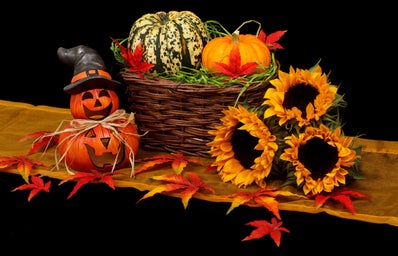A friend from abroad commented on a picture that I recently posted. The photo showed off my sister’s Halloween decor, and I honestly hadn’t thought twice about the actual nature of it. He asked me, “Why does that poster say ‘Trick-or-Treat?’”. I paused before I could answer him. I realized that I don’t know why we say “trick-or-treat”. It’s one of those cultural things I just go through the motions of. I was determined to not be an uncultured swine about tradition that I take part in- and thus the Google search began.
A Breif History of Halloween
A long, long, time ago, an ancient Celtic fire festival was celebrated annually on November 1st, called Samhain (saah-ween). It was believed that the night before Samhain, the dead would come visit Earth as ghosts, and people would place foods on their doorsteps to keep any of them from coming inside. Clearly these ghosts were not thought of all that much, as if a basket of fruit would turn off a spirit. People even dressed up as ghosts when leaving the house to try and blend in and disguise themselves from any spiritual presences. Soonafter, the Christian church adopted Samhain in their own way, as All Saint’s Day, later All Hallows’ Day. The night before All Hallows’ Day, on October 31st, was then All Hallows’ Eve- soon to be word-smooshed into Halloween.
Trick-or-Treat?
Trick or Treating started during the Middle-Ages when children would dress up, in accordance with the Celtic tradition, like angel, saints, or demons, and offer households prayers and songs in exchange for food or money. The prayers were in honor of lost loved ones, and therefore was called “souling”, the kiddos being “soulers”. This was done on All Soul’s Day, celebrated on November 2nd. Frequent treats exchanged for prayers were small cakes marked with a cross- and not too much of a surprise, they were called Soul Cakes. In the United Kingdom during the 19th century, souling turned a little more playful, and was called “guising”, short for “disguising”. The tradition involved children offering performances, like dances or reciting poems, for money or foods. Finally around the 1920’s, North America adopted their own version, trick-or-treating. Though, for about 30 years, “trick-or-treating” was more so about the trick aspect- a full day dedicated to pranks on par with Jim towards Dwight. Later, it turned into the family-friendly evening for families to take their kids around the neighborhood ringing doorbells for candy we’ve all known and loved.
Jack-o’-lanterns
In 17th century Britain, the concept of “Jack-o’-lantern” referred to a night watchman. Though we likely imagine a pumpkin, Jack originated as a “turnip lantern”, simply the concept of carving pumpkins but with turnips instead. The scary depiction of human faces were methods of keeping the young tricksters away- it would have been much less common of a sight at this time. Imagine the looks you’d get today trying to scare someone by whipping out a hollowed out turnip. Then there’s Stingy-Jack. It’s debatable whether the legend of Stingy-Jack actually appeared before the phenomena or was created as result of. The story tells that good ol’ Jack thought he could beat the system by tricking the devil into guaranteeing that he would not be dragged into Hell, regardless of his well-decorated record. But, come his judgement day, Jack wasn’t allowed into Heaven either- exactly because of his sinful life. Stingy Jack was then banished to wandering the earth for the rest of eternity. Some stories claim that Jack-o’-lanterns were carved and placed on doorsteps on All Hallows’ Eve to keep the lonely spirit of Stingy Jack away.
Remember this Halloween, the real reason we do what we do. How successful would your jack-o’-lantern and costume be?
Emery, D. (December 31, 2015). Why Do We Carve Pumpkins on Halloween?. About Entertainment. Retrieved from http://urbanlegends.about.com/od/halloween/a/Why-Do-We-Carve-Pumpkins-On…
Hiskey, D. (October 17, 2012). How the Tradition of Trick or Treating Got Started. Today I Found Out. Retrieved from http://www.todayifoundout.com/index.php/2012/10/how-the-tradition-of-tri…
Staff. (2011). History of Trick or Treating. History. Retrieved from http://www.history.com/topics/halloween/history-of-trick-or-treating
Staff. The Real Reason We Carve Pumpkins for Halloween. Tip Hero. Retrieved from http://tiphero.com/carving-pumpkin-meaning/

